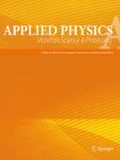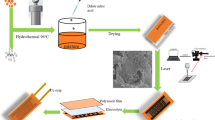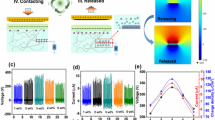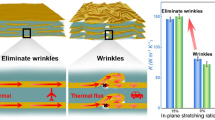Abstract
The thermoelectric properties of graphene-doped bismuth telluride–PEDOT:PSS–glycerol (hybrid) films were investigated. Prior to the study, p-type and n-type hybrid films were prepared by doping the PEDOT:PSS–glycerol with the p- and n-type bismuth telluride. Graphene-doped hybrid films were prepared by adding graphene particles of concentration ranging from 0.02 to 0.1 wt% into the hybrid films. Films of graphene-doped hybrid system were then prepared on a glass substrate using a spin-coating technique. It was found that the electrical conductivity of the hybrid films increases with the increasing of the graphene-dopant concentration and optimum at 0.08 wt% for both p- and n-type films, namely 400 and 195 S/cm, respectively. Further increasing in the concentration caused a decreasing in the electrical conductivity. Analysis of the thermoelectric properties of the films obtained that the p-type film exhibited significant improvement in its thermoelectric properties, where the thermoelectric properties increased with the increasing of the doping concentration. Meanwhile, for the case of n-type film, graphene doping showed a negative effect to the thermoelectrical properties, where the thermoelectric properties decreased with the increasing of doping concentration. Seebeck coefficient (and power factor) for optimum p-type and n-type hybrid thin films, i.e., doped with 0.08 wt% of graphene, is 20 μV/K (and 160 μW m−1 K−2) and 10 μV/K (and 19.5 μW m−1 K−2), respectively. The obtained electrical conductivity and thermoelectric properties of graphene-doped hybrid film are interestingly several orders higher than the pristine hybrid films. A thermocouple device fabricated utilizing the p- and n-type graphene-doped hybrid films can generate an electric voltage as high as 2.2 mV under a temperature difference between the hot-side and the cold-side terminal as only low as 55 K. This is equivalent to the output power as high as 24.2 nW (for output load as high as 50 Ω). The new thermoelectric device is potential for fueling a low-powered electronic device.







Similar content being viewed by others
References
A. Majumdar, Nat. Nanotechnol. 4, 214–215 (2009)
J. Karni, Nat. Mater. 10, 481–482 (2011)
L. Bell, Science 321, 1457–1461 (2008)
J.H. Yang, F.R. Stabler, J. Electron. Mater. 38, 1245–1251 (2009)
T.M. Tritt, M.A. Subramanian, MRS Bull. 31, 188–194 (2006)
G.J. Snyder, E.S. Toberer, Nat. Mater. 7, 105–114 (2008)
D. Kraemer, B. Poudel, H.-P. Feng, J.C. Caylor, B. Yu, X. Yan, Y. Ma, X. Wang, D. Wang, A. Muto, K. McEnaney, M. Chiesa, Z. Ren, G. Chen, Nat. Mater. 10, 532–538 (2011)
M.S. Dresselhaus, G. Chen, M.Y. Tang, R.G. Yang, H. Lee, D.Z. Wang, Z.F. Ren, J.P. Fleurial, P. Gogna, Adv. Mater. 19, 1043–1053 (2007)
X.B. Zhao, Appl. Phys. Lett. 86, 062111 (2005)
L.P. Bulat, J. Electron. Mater. 39, 1650–1653 (2010)
L.D. Hicks, M.S. Dresselhaus, Phys. Rev. B 47, 12727–12731 (1993)
B. Zhang, J. Sun, H.E. Katz, F. Fang, R.L. Opila, ACS Appl. Mater. Interfaces 2, 3170–3178 (2010)
O. Bubnova, Z.U. Khan, A. Malti, S. Braun, M. Fahlman, M. Berggren, X. Crispin, Nat. Mater. 10, 429–433 (2011)
N. Toshima, M. Imai, S. Ichikawa, J. Electron. Mater. 40, 898–902 (2011)
K. Kato, H. Hagino, K. Miyazaki, J. Electron. Mater. 42, 1313–1318 (2013)
N. Petruzzella, R.C. Nelson, J. Chem. Phys. 42, 3922–3926 (1965)
R. Venkatasubramanian, E. Siivola, T. Colpitts, B. O’Quinn, Nature 413, 597–602 (2001)
G. Venugopal, K. Krishnamoorthy, R. Mohan, S.-J. Kim, Mater. Chem. Phys. 132, 29–33 (2012)
I.N. Kholmanov, C.W. Magnuson, A.E. Aliev, H. Li, B. Zhang, J.W. Suk, L.L. Zhang, E. Peng, S.H. Mousavi, A.B. Khanikaev, R. Piner, G. Shvets, R.S. Ruoff, Nano Lett. 12, 5679–5683 (2012)
W.H. Kim, A.J. Mäkinen, N. Nikolov, R. Shashidhar, H. Kim, Z.H. Kafafi, Appl. Phys. Lett. 80, 3844–3846 (2002)
A.A.A. Rahman, A.A. Umar, M.H.U. Othman, Phys. E 66, 293–298 (2015)
C.B. Vining, Nat. Mater. 8, 83–85 (2009)
Y. Xu, Z. Li, W. Duan, Small 10, 2182–2199 (2014)
S.H. Lee, H. Park, W. Son, H.H. Choi, J.H. Kim, J. Mater. Chem. A 2, 13380–13387 (2014)
Y. Jiang, Q. Peng, H. Geng, H. Ma, Z. Shuai, Phys. Chem. Chem. Phys. 17, 3273–3280 (2015)
J.H. We, S.J. Kim, B.J. Cho, Energy 73, 506–512 (2014)
Acknowledgments
The authors thank the financial support from the Ministry of Higher Education of Malaysia under the research fundamental FRGS/2/2013/SG02/UKM/02/8 and the HiCOE project (AKU 95) and the Ministry of Science, Technology and Environment (MOSTE) of Malaysia under the Science Fund project no 06-01-02-SF1157.
Author information
Authors and Affiliations
Corresponding author
Rights and permissions
About this article
Cite this article
Rahman, A.A.A., Umar, A.A., Chen, X. et al. Enhanced thermoelectric properties of bismuth telluride–organic hybrid films via graphene doping. Appl. Phys. A 122, 133 (2016). https://doi.org/10.1007/s00339-016-9659-9
Received:
Accepted:
Published:
DOI: https://doi.org/10.1007/s00339-016-9659-9




